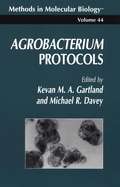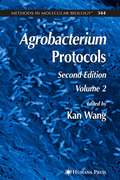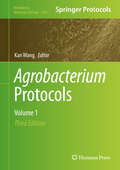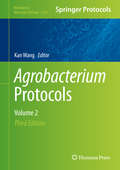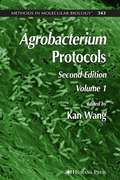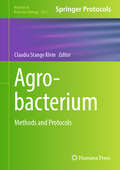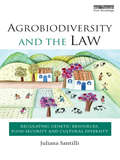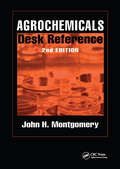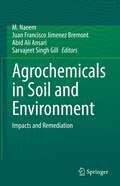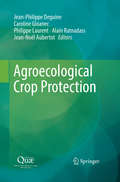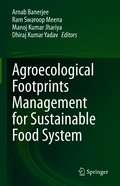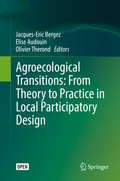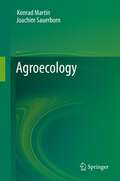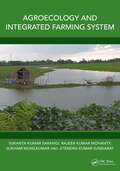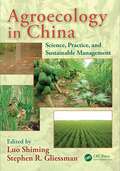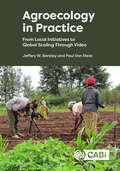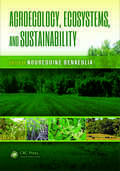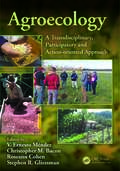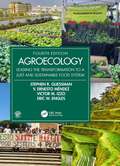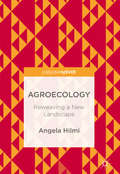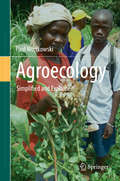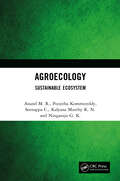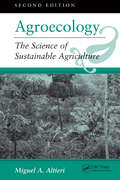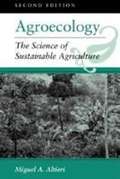- Table View
- List View
Agrobacterium Protocols (Methods in Molecular Biology #44)
by Michael R. Davey Kevan M. GartlandAgrobacterium Protocols offers beginning and experienced researchers the most comprehensive collection of step-by-step protocols for the genetic manipulation of plants using Agrobacterium. The topics range from the maintenance of bacterial culture collections to aspects of the metabolism and physiology of transformed tissues and transgenic plants. Drawing on the work of leading scientists from laboratories around the world, Agrobacterium Protocols provides a wealth of techniques for introducing specific DNA sequences into target plant species and discusses the environmental implications of genetically engineered plants. Its detailed procedures will facilitate rapid transfer of advanced techniques to other laboratories and their exploitation in fundamental and applied plant biology.
Agrobacterium Protocols, Second Edition, Volume 2: Volume II (Methods in Molecular Biology #344)
by Kan WangAgrobacterium tumefaciens is a soil bacterium that for more than a century has been known as a pathogen causing the plant crown gall disease. Unlike many other pathogens, Agrobacterium has the ability to deliver DNA to plant cells and permanently alter the plant genome. The discovery of this unique feature 30 years ago has provided plant scientists with a powerful tool to genetically transform plants for both basic research purposes and for agric- tural development. Compared to physical transformation methods such as particle bomba- ment or electroporation, Agrobacterium-mediated DNA delivery has a number of advantages. One of the features is its propensity to generate single or a low copy number of integrated transgenes with defined ends. Integration of a single transgene copy into the plant genome is less likely to trigger “gene silencing” often associated with multiple gene insertions. When the first edition of Agrobacterium Protocols was published in 1995, only a handful of plants could be routinely transformed using Agrobacterium. Ag- bacterium-mediated transformation is now commonly used to introduce DNA into many plant species, including monocotyledon crop species that were previously considered non-hosts for Agrobacterium. Most remarkable are recent devel- ments indicating that Agrobacterium can also be used to deliver DNA to non-plant species including bacteria, fungi, and even mammalian cells.
Agrobacterium Protocols, Third Edition, Volume 1: Volume 1 (Methods in Molecular Biology #1223)
by Kan WangRapid changes and significant progress have been made in the Agrobacterium field, such as genetically transforming plants for both basic research purposes and agricultural development. In Agrobacterium Protocols, Third Edition, Volumes 1 and 2, a team of leading experts and veteran researchers describe in detail techniques for delivering DNA to plant cells and permanently altering their genomes. This edition emphasizes agricultural crops and plant species with economic values, with updated protocols on 32 plant species and protocols involving 19 new species. Together with the 1st and 2nd editions, these two volumes offer Agrobacterium-mediated genetic transformation protocols for a total of 76 plant species. For a number of important plants such as rice, barley, wheat and citrus, multiple protocols using different starting plant materials for transformation are included.<P><P> Volume 1 details updated techniques available for 18 plant species drawn from cereal crops, legume plants, vegetable plants, and three model plant species: Brachypodium distachyon, Medicago truncatula, and Setaria viridis. It also updates a chapter for vector construction, a step critical to a successful plant transformation process. Written in the highly successful Methods in Molecular Biology series format, chapters include introductions to their respective topics, lists of the necessary materials and reagents, step-by-step, readily reproducible laboratory protocols, and tips on troubleshooting and avoiding known pitfalls.<P><P> Authoritative and cutting-edge, Agrobacterium Protocols, Third Edition facilitates the transfer of this rapidly developing technology to all researchers for use in both fundamental and applied biology.
Agrobacterium Protocols, Third Edition, Volume 2: Volume 2 (Methods in Molecular Biology #1224)
by Kan WangRapid changes and significant progress have been made in the Agrobacterium field, such as genetically transforming plants for both basic research purposes and agricultural development. In Agrobacterium Protocols, Third Edition, Volumes 1 and 2, a team of leading experts and veteran researchers describe in detail techniques for delivering DNA to plant cells and permanently altering their genomes. This edition emphasizes agricultural crops and plant species with economic values, with updated protocols on 32 plant species and protocols involving 19 new species. Together with the 1st and 2nd editions, these two volumes offer Agrobacterium-mediated genetic transformation protocols for a total of 76 plant species. For a number of important plants such as rice, barley, wheat and citrus, multiple protocols using different starting plant materials for transformation are included. Volume 2 contains 29 chapters with updated techniques for industrial plants, root plants, nuts and fruits, tropic plants, and other important plant species. Written in the highly successful Methods in Molecular Biology series format, chapters include introductions to their respective topics, lists of the necessary materials and reagents, step-by-step, readily reproducible laboratory protocols, and tips on troubleshooting and avoiding known pitfalls.<P><P> Authoritative and cutting-edge, Agrobacterium Protocols, Third Edition facilitates the transfer of this rapidly developing technology to all researchers in both fundamental and applied biology.
Agrobacterium Protocols: Volume I (Methods in Molecular Biology #343)
by Kan WangAgrobacterium tumefaciens is a soil bacterium that for more than a century has been known as a pathogen causing the plant crown gall disease. Unlike many other pathogens, Agrobacterium has the ability to deliver DNA to plant cells and permanently alter the plant genome. The discovery of this unique feature 30 years ago has provided plant scientists with a powerful tool to genetically transform plants for both basic research purposes and for agricultural development. Compared to physical transformation methods such as particle bomba- ment or electroporation, Agrobacterium-mediated DNA delivery has a number of advantages. One of the features is its propensity to generate a single or a low copy number of integrated transgenes with defined ends. Integration of a single transgene copy into the plant genome is less likely to trigger “gene silencing” often associated with multiple gene insertions. When the first edition of Agrobacterium Protocols was published in 1995, only a handful of plants could be routinely transformed using Agrobacterium. Agrobacterium-mediated transformation is now commonly used to introduce DNA into many plant species, including monocotyledon crop species that were previously considered non-hosts for Agrobacterium. Most remarkable are recent developments indicating that Agrobacterium can also be used to deliver DNA to non-plant species including bacteria, fungi, and even mammalian cells.
Agrobacterium: Methods and Protocols (Methods in Molecular Biology #2911)
by Claudia Stange KleinThis volume details Agrobacterium strain methods, such as plant genotype, transient and stable transformation of plants for gene overexpression, silencing, transplastomic and editing. Transformation protocols are focused mainly in plants with economic importance such as cereals and fruit trees including diploids and polyploids, and in non-plant species such fungi and algae. Written in the highly successful Methods in Molecular Biology series format, chapters include introductions to their respective topics, lists of the necessary materials and reagents, step-by-step, readily reproducible laboratory protocols, and key tips on troubleshooting and avoiding known pitfalls. Authoritative and cutting-edge, Agrobacterium: Methods and Protocols aims to be a useful and practical guide to new researchers and experts looking to expand their knowledge.
Agrobiodiversity and the Law: Regulating Genetic Resources, Food Security and Cultural Diversity
by Juliana SantilliA wide range of crop genetic resources is vital for future food security. Loss of agricultural biodiversity increases the risk of relying on a limited number of staple food crops. However, many laws, such as seed laws, plant varieties protection and access and benefit-sharing laws, have direct impacts on agrobiodiversity, and their effects have been severely underestimated by policy-makers. This is of concern not only to lawyers, but also to agronomists, biologists, and social scientists, all of whom need clear guidance as to the relevance of the law to their work. This book analyzes the impact of the legal system on agrobiodiversity (or agricultural biodiversity) – the diversity of agricultural species, varieties, and ecosystems. Using an interdisciplinary approach, it takes up the emerging concept of agrobiodiversity and its relationship with food security, nutrition, health, environmental sustainability, and climate change. It assesses the impacts on agrobiodiversity of key legal instruments, including seeds laws, the International Convention for the Protection of New Varieties of Plants, plant breeders’ rights, the Convention on Biological Diversity (regarding specifically its impact on agrobiodiversity), and the International Treaty on Plant Genetic Resources for Food and Agriculture. It also reviews the options for the implementation of these instruments at the national level in several countries. It discusses the interfaces between the free software movement, the ‘commons’ movement, and seeds, as well as the legal instruments to protect cultural heritage and their application to safeguard agrobiodiversity-rich systems. Finally, it analyzes the role of protected areas and the possibility of using geographical indications to enhance the value of agrobiodiversity products and processes.
Agrochemicals Desk Reference
by John H. MontgomeryThe Agrochemicals Desk Reference is a revised volume inspired by the growing number of research publications and continued interest in the fate, transport, and remediation of hazardous substances. Much data has been added to this edition, reflecting the wealth of literature in the field. Featured are environmental and physical/chemical data on more than 200 compounds, including pesticides, herbicides, and fungicides. All compounds are listed in alphabetical order, making it easy to find the data you need. The text is fully indexed by CAS number, RTECS number, empirical number, and synonyms.
Agrochemicals in Soil and Environment: Impacts and Remediation
by Sarvajeet Singh Gill M. Naeem Abid Ali Ansari Juan Francisco Jimenez BremontThis volume ‘Agrochemicals in Soil and Environment: Impacts and Remediation’ is a comprehensive collection of important literature on agrochemical contamination. The main focus of this book is to point out undesirable changes in biological, physical and chemical characteristics of agricultural soils and its impacts on global agricultural crop productivity. Soil is one of the important resources of basic needs for our sustenance but due to various anthropogenic activities like urbanization and industrialization, the soil is losing its basic quality characteristics. Soil microorganisms, water holding capacity, minerals, salts and nutrients are under the direct threat due to agrochemicals therefore, agricultural sector is facing a serious challenge. Lack of proper knowledge and luxurious applications of agrochemicals resulting into degradation and deterioration of soil quality, loss of soil and crop productivity and threatening the food security. Therefore, it is imperative to develop indices, indicators and soil parameters for the monitoring and impact assessment of agricultural contaminants. Further, biotic and abiotic stresses and their tolerance mechanisms in plants in relation to the soil contaminants such as toxic pollutants, heavy metals, inorganic and organic matters, variety of pesticides, insecticides, herbicides, agricultural runoffs and solid wastes, and chemical fertilizers are also highlighted in this volume. This book also discusses causes of reduced agriculture productivity and suggests sustainable measures such as plant-based technologies, bioremediation and nanotechnology, that can be used to overcome the crop losses. The book is interest to research students, teachers, agricultural scientists, agronomists, environmentalists as well as policy makers.
Agroecological Crop Protection
by Jean-Philippe Deguine Caroline Gloanec Philippe Laurent Alain Ratnadass Jean-Noël AubertotThis book is devoted to Agroecological Crop Protection, which is the declension of the principles of agroecology to crop protection. It presents the concepts of this innovative approach, case studies and lessons and generic keys for agroecological transition. The book is intended for a wide audience, including scientists, experimenters, teachers, farmers, students. It represents a new tool, proposing concrete keys of action on the basis of feedbacks validated scientifically. Beyond the examples presented, it is therefore of general scope and proposes recommendations for all temperate and tropical cropping systems. It contributes to the training and teaching modules in this field and it is an updated information support for professionals and a teaching aid for students (agronomy, crop protection, biodiversity management, agroecology).
Agroecological Footprints Management for Sustainable Food System
by Ram Swaroop Meena Manoj Kumar Jhariya Arnab Banerjee Dhiraj Kumar YadavAgroecological footprints are a unique and popular concept for sustainable food system. Measuring and keeping a tab on the agroecological footprints of various human activities has gained remarkable interest in the past decade. From a range of human activities, food production and agriculture are most essential as well as extremely dependent on the agroecosystems. It is therefore crucial to understand the interaction of agroecosystem constituents with the extensive agricultural practices. The environmental impact measured in terms of agroecological footprints for a healthy for the sustainable food system. The editors critically examine the status of agroecological footprints and how it can be maintained within sustainable limits. Drawing upon research and examples from around the world, the book is offering an up-to-date account, and insight into how agroecology can be implemented as a solution in the form of eco-friendly practices that would boost up the production, curbs the environmental impacts, improves the bio-capacity, and reduces the agroecological footprints.It further discusses the changing status of the agroecological footprints and the growth of other footprint tools and types, such as land, water, carbon, nitrogen, etc. This book will be of interest to teachers, researchers, government planners, climate change scientists, capacity builders, and policymakers. Also, the book serves as additional reading material for undergraduate and graduate students of agriculture, agroforestry, agroecology, soil science, and environmental sciences.National and international agricultural scientists, policymakers will also find this to be useful to achieve the ‘Sustainable Development Goals’.
Agroecological Transitions: From Theory To Practice In Local Participatory Design
by Jacques-Eric Bergez Elise Audouin Olivier TherondThis Open Access book presents feedback from the ‘Territorial Agroecological Transition in Action’- TATA-BOX research project, which was devoted to these specific issues. The multidisciplinary and multi-organisation research team steered a four-year action-research process in two territories of France. It also presents:i) the key dimensions to be considered when dealing with agroecological transition: diversity of agriculture models, management of uncertainties, polycentric governance, autonomies, and role of actors’ networks;ii) an operational and original participatory process and associated boundary tools to support local stakeholders in shifting from a shared diagnosis to a shared action plan for transition, and in so doing developing mutual understanding and involvement;iii) an analysis of the main effects of the methodology on research organisation and on stakeholders’ development and application;iv) critical analysis and foresights on the main outcomes of TATA-BOX, provided by external researchers.
Agroecology
by Joachim Sauerborn Konrad MartinThis book represents an interdisciplinary approach to the relevant aspects of agricultural production related to the interactions between natural processes, human activities and the environment. It provides condensed and comprehensive knowledge on the functions of various agroecosystems at the field, landscape and global scale. Understanding and integrating complex ecological processes into field production, land management and food systems is essential in order to deal with the challenges of modern crop and livestock production: the need for food security for the growing human population, and the necessity to combat the detrimental effects of food production on the environment. The book provides the scientific basis required by students and scientists involved in the development of sustainable agroecosystems and contributes to a range of disciplines including Agriculture, Biology, Geography, Landscape Ecology, Organic Farming, Biological Control, and Global Change Ecology.
Agroecology Now!: Transformations Towards More Just and Sustainable Food Systems
by M. Jahi Chappell Colin Ray Anderson Janneke Bruil Csilla Kiss Michel Patrick PimbertThis open access book develops a framework for advancing agroecology transformations focusing on power, politics and governance. It explores the potential of agroecology as a sustainable and socially just alternative to today’s dominant food regime. Agroecology is an ecological approach to farming that addresses climate change and biodiversity loss while contributing to the Sustainable Development Goals. Agroecology transformations represent a challenge to the power of corporations in controlling food system and a rejection of the industrial food systems that are at the root of many social and ecological ills. In this book the authors analyse the conditions that enable and disable agroecology’s potential and present six ‘domains of transformation’ where it comes into conflict with the dominant food system. They argue that food sovereignty, community-self organization and a shift to bottom-up governance are critical for the transformation to a socially just and ecologically viable food system. This book will be a valuable resource to researchers, students, policy makers and professionals across multidisciplinary areas including in the fields of food politics, international development, sustainability and resilience.
Agroecology and Integrated Farming System
by Sukanta Kumar Sarangi Rajeeb Kumar Mohanty Sukham Munilkumar Jitendra Kumar SundarayIn most developing countries, agriculture has grown from merely an art to a science, but it does not yet maximize its business potential. In these countries, subsistence farming dominates, and farmers face the increasing impact of climate change and natural disasters. An integrated farming system (IFS) model yields minimum risk and maximum environmental benefit. The latest cutting-edge technologies applicable to each component of IFS and the science behind an agro-ecological approach are discussed at length in this book, which takes a holistic approach towards sustainable agricultural production technologies that result in maximum profit for the farming community. Also, it considers practices that care for natural resource bases and leave behind minimal environmental footprints. To keep prepared for climate change and natural disasters, appropriate contingency measures to tackle these unwanted situations are detailed.The book offers comprehensive coverage of the most essential topics, including: Modern technologies, new concepts and innovations such as 3D farming, Integrated System of Rice Intensification (ISRI), hydroponics, rooftop farming and water budgeting. The use of IT for supporting IFS and environmental aspects related to greenhouse gas (GHG) emission. Information on organic farming covering all its aspects, present situation, market-related issues and future options. In-situ input generation procedures that are integral to recycling and their effective reuse. Region-specific IFS models based on soil, climate and farmers' requirements for different agroclimatic situations. IFS management aspects including water harvesting, conservation, increased productivity and drainage Latest information on the socio-economic factors, impacts, government orientations, policy framework towards agriculture and environmental aspects, and the future road map to make IFS a success. This book will serve as a handy reference for academics, researchers, students, progressive farmers and policymakers aiming to make agriculture more resilient, sustainable and eco-friendly.
Agroecology in China: Science, Practice, and Sustainable Management (Advances in Agroecology #22)
by Stephen R. Gliessman Luo ShimingKey features: Reviews the development of agroecology in China, including research, practice, management, and education regarding challenges for rural and agricultural progress Presents information from sources not readily available in the West about agricultural development in China during the last several decades Provides models and indicates starting points for future research and practice Addresses how to meet future challenges of agroecosystems from the field to the table in China from scientific, technological, and management perspectives During the past 30 years, industrialization has fundamentally changed traditional rural life and agricultural practices in China. While the incomes of farmers have increased, serious issues have been raised concerning the environment, resource depletion, and food safety. In response, the Chinese government and Chinese scientists encouraged eco-agriculture, the practice of agroecology principles and philosophy, as a way to reduce the negative consequences of large-scale industrialized systems of farming. Agroecology in China: Science, Practice, and Sustainable Management represents the work of experts and leaders who have taught, researched, and expanded Chinese agroecology and eco-agriculture for more than 30 years. It reviews decades of agricultural change to provide an integrated analysis of the progress of research and development in agroecological farming practices. The book contains research on traditional and newly developed agricultural systems in China, including intercropping systems, rainfall harvest systems, and rice–duck, rice–fish, and rice–frog co-culture systems. It covers current eco-agriculture practices in the major regions of China according to climate conditions. The book closes with a discussion of the major technical approaches, necessary policy support, and possible major development stages that must occur to allow broader agroecological implementations toward the sustainability of future food systems in China. Presenting eco-agriculture systems that are somewhat unique in comparison to those of the United States, Latin America, and Europe, Agroecology in China gives insight on how Chinese agroecologists, under the political and cultural systems specific to China, have created a strong foundation for ecologically sound agroecosystem design and management that can be applied and adapted to food systems elsewhere in the world. By using selected regional examinations of agroecological efforts in China as examples, this book provides models of how to conduct research on a broad range of agroecosystems found worldwide.
Agroecology in Practice: From Local Initiatives to Global Scaling Through Video
by Jeffery W Bentley Paul Van MeleIndustrial agriculture has taken a toll on our soils, environment and local food cultures. Agroecology in Practice offers a beacon of hope. This practical guide shares ideas and techniques with readers seeking to implement agroecological principles. This book presents innovative examples from across the globe on how to: Rebuild soil health and fertility Enhance biodiversity on your farm Conserve water resources Manage pests and diseases sustainably Ensure humane livestock care Support farmer cooperation Build local food systems. This book inspires the reader with real-world examples. It also explores the multiple ways in which video can contribute to building the necessary knowledge to transform food systems. Agroecology in Practice is a must-read for: Farmers seeking to transition to more sustainable practices Agricultural professionals and educators Students of agroecology Policymakers and anyone interested in a healthier future for our planet. Each short section in the book is linked to a relevant video on the award-winning platform Access Agriculture (www.accessagriculture.org). These 132 high-quality video demonstrations and explanations bring the book's content to life, thereby enriching the learning experiences for readers. These videos share a visual and engaging way to learn, complementing the written content in the book. We hope that having this rich multimedia component will make the book attractive to a wide audience.
Agroecology, Ecosystems, and Sustainability (Advances in Agroecology)
by Noureddine BenkebliaWe hear a lot about how agriculture affects climate change and other environmental issues, but we hear little about how these issues affect agriculture. When we look at both sides of the issues, we can develop better solutions for sustainable agriculture without adversely affecting the environment. Agroecology, Ecosystems, and Sustainability explor
Agroecology: A Transdisciplinary, Participatory and Action-oriented Approach (Advances in Agroecology)
by Stephen R. Gliessman Christopher M. Bacon Roseann Cohen V. Ernesto MéndezAgroecology: A Transdisciplinary, Participatory and Action-oriented Approach is the first book to focus on agroecology as a transdisciplinary, participatory, and action-oriented process. Using a combined theoretical and practical approach, this collection of work from pioneers in the subject along with the latest generation of acknowledged leaders
Agroecology: Leading the Transformation to a Just and Sustainable Food System (Advances in Agroecology)
by Stephen R. Gliessman V. Ernesto Méndez Victor M. Izzo Eric W. EnglesAgroecology is at the forefront of transforming our food systems. This bestselling textbook provides the essential foundation for understanding this transformation in all its components: agricultural, ecological, economic, social, cultural, and political. It presents a case for food system change, explains the principles and practices underlying the ecological approach to food production, and lays out a vision for a food system based on equity and greater compatibility with the planet’s life support systems. New to the fourth edition: A chapter on Alternatives to Industrial Agriculture, covering the similarities and distinctions among different approaches to sustainable agriculture A chapter on Ecological Pest, Weed, and Disease Management A chapter on Urban and Peri-urban Agriculture A chapter on Agriculture and the Climate Crisis A revised analysis and critique of the food system’s embeddedness in the extractive capitalist world economy that reflects ideas in the emerging field of political agroecology. Streamlined treatment of agroecology’s foundations in ecological science, making the text more compatible with typical course curricula. A Companion Website incorporates the entire contents of the updated practical manual Field and Laboratory Investigations in Agroecology, split into student and lecturer resources. These 24 sample investigations facilitate hands-on learning that involves close observation, creative interpretation, and constant questioning of findings. Groundbreaking in its first edition and established as the definitive text in its second and third, the fourth edition of Agroecology captures recent developments in the field and forcefully applies the idea that agroecology is a science, a movement, and a practice. Written by a team of experts, this book will encourage students and practitioners to consider the critical importance of transitioning to a new paradigm for food and agriculture.
Agroecology: Reweaving a New Landscape
by Angela HilmiThis book argues that sustainable development, based on sustained growth, has led us to an impasse. In response, Agroecology brings back and utilises notions of eco-development and co-evolution with nature as a refreshing paradigm. It also proposes a further shift in mindset with the notion of being within, or looking at agroecology as a way to reconnect and rebuild relationships and movement within farming systems and beyond. Rather than linear technical fixes, it considers the critical nodes of tension, the inflection points, or acupoints, which can trigger a transition towards greater harmony and well-being. The book also draws from a concrete example of agroecology by examining a pilot project in Mozambique testing new approaches to investments and peasant farming that will inspire farming communities, researchers, policy makers and development organizations alike, to build greater autonomy and self-determination.
Agroecology: Simplified and Explained
by Paul WojtkowskiThis book presents the core elements that underwrite agroecology. Expressed across twelve chapters, the universality of the core is the essence of agroecology. This alone would be of interest to researchers, students, and academics. Furthermore, the book contains a long, detailed, and inclusive glossary that, with over 160 entries, elaborates on the topics presented. Included are recent developments as well as time-tested, traditional farm practices. The book also advances the theoretical base, fills gaps in the published research, and suggests future opportunities and future directions. The book is internationally oriented, presenting both temperate and tropical agriculture. The book begins by comparing agroecology against conventional, monoculturally-based agriculture. In doing so, it defines the unique features of agroecology and their significance in achieving sustainable and environmentally-friendly agriculture. The book goes on to discuss the underlying technologies, the various manifestations of biodiversity, and the risk countermeasures associated with agroecology. This includes the farm landscape as a positive base for ecology, and how, if used well, it can produce major economic growth. The book concludes by summarizing the key findings, and assessing the macro-challenges facing agroecology.
Agroecology: Sustainable Ecosystem
by Anand M. R. Poojitha Kommireddy Seenappa C. Kalyana Murthy K. N. Ningaraju G. K.Agroecology literacy is 'the degree to which people have an objective and well-informed understanding of crop production with environmental issues.' The increased food grain production has also increased the unscientific and indiscriminate use of agrochemicals which has affected the soil health and degraded agroecosystem adversely and brought down the immunity of soil and the productivity of crops. In addition, it has resulted in the over-exploitation of soil, leading to nutrient imbalance. Moreover, the negative impact of chemical agriculture on the environment and human health has been reported and documented. Increased environmental awareness and health consciousness promoted scientists and planners to think about sustainable farming practices as an alternate way for healthy agriculture to protect the environment and human health. Eco-friendly methods or ecosystem services are one solution to manage this issue. This book intends to provide the core elements of a curriculum for teaching agroecology at colleges and universities. Print edition not for sale in India.
Agroecology: The Science Of Sustainable Agriculture, Second Edition (Agrarian Change And Peasant Studies #7)
by Miguel A AltieriThis new edition builds on the explosion of research on sustainable agriculture since the late 1980s. By separating myth from reality, Miguel Altieri extracts the key principles of sustainable agriculture and expounds on management systems that "really work." Providing case studies of sustainable rural development in developing countries, he goes beyond a mere description of practices to include data that reveal the socioeconomic and environmental impacts of alternative projects. Each chapter of Agroecology has been enriched and updated with the latest research results from around the world. New emphasis has been placed on such issues as the ecological economics of agriculture, policy changes needed for promoting sustainable agriculture, rural development in the Third World, the role of biodiversity in agriculture, and new research methodologies.
Agroecology: The Science of Sustainable Agriculture (2nd Edition)
by Miguel A. AltieriThis new edition builds on the explosion of research on sustainable agriculture since the late 1980s. By separating myth from reality, Miguel Altieri extracts the key principles of sustainable agriculture and expounds on management systems that "really work. " Providing case studies of sustainable rural development in developing countries, he goes beyond a mere description of practices to include data that reveal the socioeconomic and environmental impacts of alternative projects. Each chapter of Agroecology has been enriched and updated with the latest research results from around the world. New emphasis has been placed on such issues as the ecological economics of agriculture, policy changes needed for promoting sustainable agriculture, rural development in the Third World, the role of biodiversity in agriculture, and new research methodologies.
